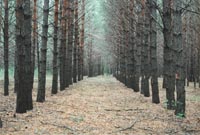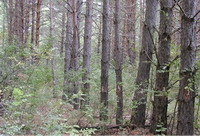Abstract
Assessing the capacity of bog
sites to support forest growth was based on confident indicators, such as peat
soil chemical properties, forest inventory data, foliage analysis results, and
shoot parameters, determined when identifying Scots pine bog site types. These
characteristics describe two major site fertility criteria: nutrient content of
soil and forest stand productivity. Moderately drained eutrophic bog site conditions
were taken as a standard (100 points). Reclamation of oligotrophic bog sites
estimated at up to 10 points appeared to be economically ineffective, whereas
fertilizer application, apart from land improvement by hydraulic engineering
methods, was found to be needed in case of oligomesotropic, mesotrophic, and
mesoeutrophic bog sites (18-21 points). Moisture regime regulation was
determined to be a sufficient land improvement measure for 65-point Scots pine
eutrophic bog sites.
Needle morphometric parameters of Scots pine stands growing on undrained
bog sites exhibited significant variability among bog types: needle length was
33±0.4 mm
and weighted 1.9±0.03 g
for oligotrophic sites, with the similar characteristics being 60±0.6 mm and 3.60±0.2 g for eutrophic bogs and
40±0.5 mm
and 2.4±0.06 g
for oligomesotrophic, mesotrophic, and mesoeutrophic sites.
A paired regression analysis revealed a positive
linear relationship of wood biomass increment and needle length:
y = – 1,62 + 0,076x; R2
= 0,96, p = 0,000,
where y is stand life-span annual wood biomass increment, cubic
m/ha; x is one-year-old needle length, mm; R2 is
determination index; and p is significance level.
The study results obtained on morphometric characteristics of Scots pine
needles provide foresters with simple and user-friendly criteria for estimating
suitability of bog sites for forest growth and the above linear function allows
to predict effectiveness of Scots pine bog site reclamation regarding post-treatment
forest productivity.
Key words: Scots pine stands
growing on bog, bog site types, needle morphometric parameters
References
Amponsach, I.G. Effects of
repeated fertilization on needle longevity, foliar nutrition, effective leaf
area index, and growth characteristics of lodgepole pine in interior British
Columbia, Canada / I.G. Amponsach,
P.G. Comeau, R.P. Brockley, V.J. Lieffers // Can. J. For. Res. – 2005. – V. 35. – № 2. – P. 440-451.
Ohlson,
M. Growth
and nutrient characteristics in bog and fen populations of Scots pine (Pinus
sylvestris) / М.
Ohlson // Plant and Soil. – 1995. – V. 172. – № 2.
– P. 235-245.
Wheeler,
B.D. Phytometric assessment of the fertility of underained
rich-fen soils / B.D. Wheeler, S.C.
Shaw, R.E.D. Cook // J. Appl. Ecol. – 1992. – № 2. – P.
466-475.
Yang,
R.C.
Foliage and shard growth responses of semimature lodgepole pine to thinning and
fertilization / R.C. Yang
// Can. J. For. Res. –
1998. – V. 28. – № 12. – P. 1794-1804.
Youngblood,
A. Changes needle morphology of shade tolerant seedlings after partial
overstory canopy removal / A.
Youngblood, D.E. Ferguson // Can. J. For. Res. – 2003. – V. 33.
– № 7. – P. 1315-1322.
Вайчис, М. Шкала оценки
плодородия лесных почв и производительности насаждений / М. Вайчис, А. Руткаускас. – Каунас: ЛитНИИЛХ, 1973.
– 8 с.
Доспехов, Б.А. Методика
полевого опыта (с основами статистической обработки результатов исследования) /
Б.А. Доспехов. – М.: Колос,
1973. – 336 с.
Ефремов, С.П. Естественное залесение осушенных болот
лесной зоны Западной Сибири / С.П. Ефремов. – М.: Наука, 1972. –
155 с.
Ефремова, Т.Т. Гумусное состояние почв болотных сосняков Западной Сибири
/ Т.Т. Ефремова // Почвы сосновых лесов Сибири. – Красноярск, 1986. –
С.33-46.
Ефремова, Т.Т. Связь производительности болотных сосняков Западной Сибири
с почвенными условиями / Т.Т. Ефремова, С.П. Ефремов, В.П. Черкашин // Лесоведение.
– 1995. – № 2. – С.
50-59.
Ефремова, Т.Т. Трофическая оценка лесоводственной продуктивности
торфяных почв Западной Сибири / Т.Т. Ефремова, С.П. Ефремов, В.П. Черкашин // Сибирский
биологический журнал. – 1993. – № 6. – С. 41-48.
Ефремова, Т.Т., Оценка плодородия лесных торфяных почв Западной Сибири
методами растительной диагностики / Т.Т. Ефремова [и др.] // Почвоведение. – 1996. – № 7. – С.
879-887.
Ефремова, Т.Т. Опыт применения методов многомерного
статистического анализа для группировки типов условий произрастания болотных
сосняков Западной Сибири / Т.Т. Ефремова [и др.] // Лесоведение. – 2002. – №2. – С.
53-62.
Згуровская, Л.Н.
Исследование хвои сосны и кедра на болотах разных типов / Л.Н. Згуровская //
Ботанический журнал. – 1965. – Том 50. – № 2. – С.
234-237.
Константинов В.К. Современное состояние гидролесомелиорации: актуальные
практические и научные задачи / В.К. Константинов, Н.А. Красильников, С.В.
Хитрин // Болота и заболоченные леса в свете задач устойчивого природопользования.
– М.: Геос, 1999. – С. 261-264.
Корчагина, М.П. Морфометрическая характеристика хвои сосны обыкновенной
на осушенных торфяных почвах / М.П. Корчагина // Изменение лесоболотных
биогеоценозов под влиянием осушения. –
Петрозаводск, 1986. – С. 62-82.
Мелентьева, Н.В. Почвы осушенных лесных болот / Н.В. Мелентьева. – Новосибирск: Наука, 1980. – 128 с.
Орлов, А.Я. Почвенная экология сосны / А.Я. Орлов, С.П. Кошельков. – М.: Наука, 1971. – 324 с.
Поргасаар, В.И. Диагностика минерального питания
сосны обыкновенной / В.И. Поргасаар // Агрохимия. – 1977. – № 5. – С. 120-127.
Прокушкин, С.Г. Минеральное питание сосны / С.Г. Прокушкин. – Новосибирск: Наука, 1982. – 190 с.
Чекотовский, Э.В. Графический анализ статистических
данных в Microsoft Excel 2000 / Э.В. Чекотовский. – М.: Издательский дом «Вильямс», 2002. – 464 с.





